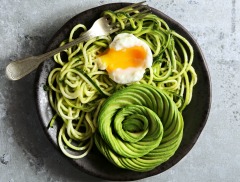Don't just meal plan... meal plan intelligently - with Meal Genius! Sign up for our free newsletter to get delicious recipes, sample meal plans and a whole lot more!
Sour Cream
Sour cream is produced by introducing a probiotic bacterial culture into cream. The culture produces lactic acid, which sours and thickens the cream.
Ranging from 18 to 20 percent fat, sour cream often contains additional ingredients such as gelatin, rennin and enzymes.
Light sour cream is made from half-and-half and contains about 40 percent less fat than regular sour cream; nonfat sour cream is thickened with stabilizers.
As with all dairy products, choose organic sour cream (preferably from grass-fed cows) that is rBGH-free.
The Benefits
- Special diets: Diabetic, Gluten-Free Diet, Grain-Free Diet, Low Carb Diet, Low FODMAP Diet, Low Histamine Diet, Low Oxalate Diet, Low Starch Diet, PCOS Diet, Pescetarian Diet, Primal Diet, Vegetarian Diet
- Excellent Source of:
- Good Source of:
- Preferences: No Fish, No Pork, No Eggs, No Shellfish, No Gluten, No Nuts, No Seeds, No Soy, No Poultry, No Red Meat, No Corn, No Yeast, No Peanuts, No Coconut, No Pseudograins, No Citrus, No Nightshade, No Legumes, No Grains, Low Carbohydrate, Low Cholesterol, Low Fat, Low Sodium, Low Sugars, Low Saturated Fat
Related Foods
Related Recipes
Selecting and Storing
Refrigerate sour cream for up to a week after the date stamped on the bottom of the container. If mold forms on the cream`s surface, discard it immediately.









